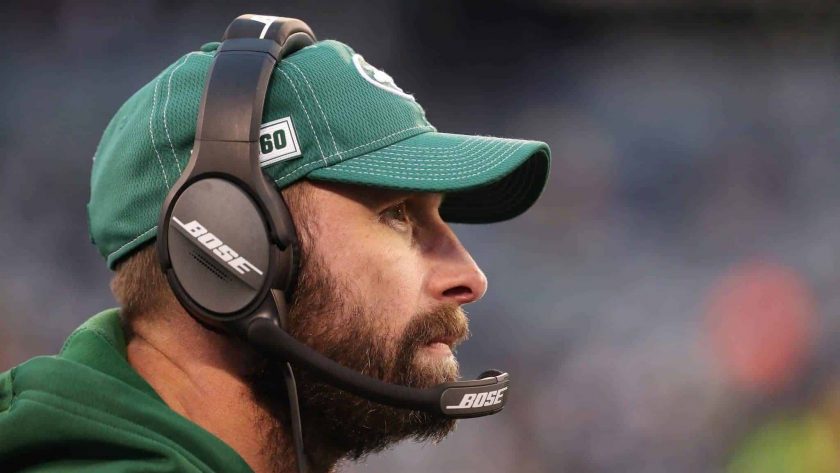Adam Gase’s antiquated offense is setting up the New York Jets for failure

New York Jets head coach Adam Gase doesn’t have much talent to work with on offense, but his scheme isn’t doing anyone any favors.
[sc name=”kyle-newman-banner” ]It’s not Adam Gase‘s fault the New York Jets are in their current state. He came to a team that had little talent, a bad general manager, and little draft capital. This was never going to be a quick turnaround.
However, Gase’s poor offensive scheme that has lagged far behind the rest of the NFL is on him. He refuses to make any sort of adjustments to his offensive scheme that could help the team.
Even the use of basic offensive techniques that make life easier for your quarterbacks like play-action and motion are nearly non-existent. When you refuse to make life easy on your quarterback, odds are you aren’t going to win many games. That’s especially true when the team lacks the talent to make up for the poor scheme.
If Gase is going to turn things around and save his job, then he’s going to need to make major changes. There are three changes he could make that should immediately improve the team’s overall offensive capability.
Motion
Maybe the most egregious example of Gase’s antiquated scheme is his use of motion or lack thereof. The NFL has upped the use of motion every year. It’s a part of the game that proves effective in both the pass and run game.
Using motion before the snap can show a quarterback if it’s a man or zone defense—a key distinction. Used at the snap it can get a defense out of position and make life easier for the running back or the quarterback.
ESPN analytics have found that the expected yards per play go up significantly when teams use motion. This is especially true of motion at the snap.
ESPN analytics finds that the best offensive minds in the NFL have leaned into this heavily. Greg Roman’s Ravens offense used motion on 69% of plays and motion at the snap on 26.3% of the time. Sean McVay’s Rams offense used motion 58.3% of the time and motion at the snap 33.8% of the time. Andy Reid’s Chiefs offense used motion 62.7% of the time and motion at the snap 19.4% of the time.
The top offensive minds in the game have all gravitated to motion as a way to make life easier on their young quarterback. In fact, 12 teams in total used motion on at least 50% of offensive snaps. Those teams averaged 29.3 points per game and went 11-1 in Week 1. Twelve teams used motion at the snap at least 15% of the time, averaging 29.8 points per game and going 12-0 in Week 1.
Now, motion at the snap isn’t the be all end all of offensive production. Teams that use a ton of motion aren’t going to go undefeated this year. However, it’s clearly a way to create an advantage, especially when your opponent hasn’t had the time to prepare due to a lack of preseason.
Logic follows, that Gase should make this a staple of his offense for his young quarterback, but he hasn’t. In fact, Gase is one of the last remaining fighters against the use of motion.
The Jets used motion on just 22.6% of plays, the second-lowest in the NFL, and motion at the snap just 2% of the time, the fifth-least in the NFL. Six teams used motion 30% or less in Week 1, they averaged 17.2 points per game and went 0-6. Seven teams used motion at the snap 5% of the time or less, they averaged 18 points per game and went 0-7.
If Gase wants to make the most of his weak offensive talent, he can start by leaning into the top trends in the NFL. Motion is an easy one to use that will make everything easier for Sam Darnold. By not using motion, Gase is simply making life needlessly difficult on his quarterback.
Teams that make life more difficult on their quarterback then necessary end up losing games. It’s that simple.
Second and Long
Adam Gase has a peculiar taste in play calling. On second and long most teams in the NFL prefer to throw the ball. In fact, according to Sharp football stats, teams ran the ball just 34% of the time on second and 8-10 and 25% of the time on 2nd and 11+ in 2019.
It’s a simple idea to understand in concept. When you get to second and long, the best thing to do is throw the ball to make the third down as manageable as possible. That concept didn’t register with Gase in 2019.
Instead, he ran the ball 39% of the time on second and 8-10 and 38% of the time on second and 11+. Massive swings above the league average. That would make sense if it was working, but it was an unmitigated disaster the majority of the time.
The most frequently run play for the Jets on second and 8-10 was a Le’Veon Bell run, which was successful just 23% of the time. Similarly, the most frequently run play on second and 11+ was a Le’Veon Bell run and it was successful just 9% of the time.
Meanwhile, the Jets were finding mild success throwing the ball on second and long. Jamison Crowder was the Jets’ most frequent pass target on second and 8-10 and plays to him were successful 55% of the time. More than double the success rate of runs with Bell. Despite that, the Jets threw the ball to Crowder three times fewer than they ran the ball with Bell.
Gase didn’t make much of an adjustment in Week 1. He faced second and 8-10 four times and he ran the ball twice and threw it twice. One of the two passes was successful, but neither of the run plays were.
The big change comes on second and 11+, which the Jets faced three times. Gase passed on all three occasions. However, that comes with a caveat, two of the three passes were screens and neither were successful.
Gase seems determined to make his players work harder for yardage on second and long then they need to. When players are put in positions to fail like that, usually they do. That’s why the Jets faced more third and longs than any team in the NFL in 2019 and are on their way to a similar result in 2020.
Avoiding players’ strengths
The numbers show that Adam Gase’s offense is putting his team at a disadvantage. He’s not using modern techniques to make life easier on his quarterback and his sub-optimal play-calling is putting the offense in a position to fail.
That’s only the start of it. The worst culprit here is that Gase’s play-calling seems designed to go right into the weaknesses of his players rather than their strengths.
Take Le’Veon Bell for example. The star running back made his name with his patient running style helping him find holes, sometimes up the middle but mostly outside the tackles. When Bell is in space he’s one of the most dangerous players in the NFL.
Yet, Gase rarely used Bell outside the tackles in 2019. The Jets ran the Ball up the middle on 68% of runs. They only went outside the tackles on 13% of runs, 8% outside of the left tackle and 5% outside of the right tackle.
What’s astonishing is the trend of success. The Jets were 27th in the NFL in adjusted line yards up the middle, meaning they weren’t getting push up the middle. That led to Bell having the least amount of yardage before contact in the NFL in 2019. However, the Jets were seventh in the NFL in adjusted line yards in runs outside the left tackle.
Despite that, the Jets were 21st in percentage of runs of the left tackle. Yet, they were second in the NFL in percentage of runs up the middle. Gase continued to plow ahead with a gameplan that didn’t work instead of adjusting to fit what his team was good at. Thus, Bell looked like a scrub in 2019.
Things have yet to improve in 2020. In Week 1, 86% of the Jets runs were up the middle and the Jets never ran outside the tackle. This is an astonishing feat considering the Jets drafted Mekhi Becton, an offensive lineman known for his run-blocking prowess. They didn’t use that to their advantage once in Week 1.
Things don’t stop at the running game. Gase has also taken Darnold out of his comfort zone. When Darnold entered the league he was best in the short passing game and struggled mightily when asked to throw 15+ yards out.
When Gase came in, he increased those short passes to an insane degree, which limits Darnold’s strength. Without deep passes to keep the safties in check the short game becomes harder to operate.
Linebackers and safeties stay in the middle of the field, and they swarm to receivers quickly. When yards after the catch are limited, the short passing game becomes just about as effective as running the football.
Jets’ fans saw that at work on Sunday. Outside of Jamison Crowder’s 69-yard touchdown. Darnold only averaged about three yards per pass despite throwing the ball about 4.1 air yards per pass. He was actually losing yards from YAC rather than gaining it.
That’s what happens when the offense calls for nearly two-thirds of the passes to travel only five yards or less in the air. 65.6% of Darnold’s completions in 2019 were five yards or less in the air. The NFL average was just 58.2%.
In Week 1 of 2020, the Jets threw the ball at least 10 yards in the air just 11 times, completing three of them. Darnold threw over 60% of his passes five yards or less in week 1 again. Proving that Gase hasn’t found the fault in his scheme.
It’s good to try and catch defenses off guard or scheme to your quarterback’s strength, but it only hurts the team when things get taken to the extreme. It makes those plays calls predictable and only works to take away those strengths and the element of surprise.
When the offense becomes too predictable, life is harder on the offensive players. They can only do so much when the defense knows what play is coming next.
BET $5 & GET $150 IN BONUS BETS INSTANTLY! BET $5, GET $150 BONUS! $1,000 BET ON CAESARS! BET $5, GET $158 BONUS! GET $150 BONUS OR $2,000 FIRST-BET SAFETY NET!
A contributor here at elitesportsny.com. I'm a former graduate student at Loyola University Chicago here I earned my MA in History. I'm an avid Mets, Jets, Knicks, and Rangers fan. I am also a prodigious prospect nerd and do in-depth statistical analysis.











